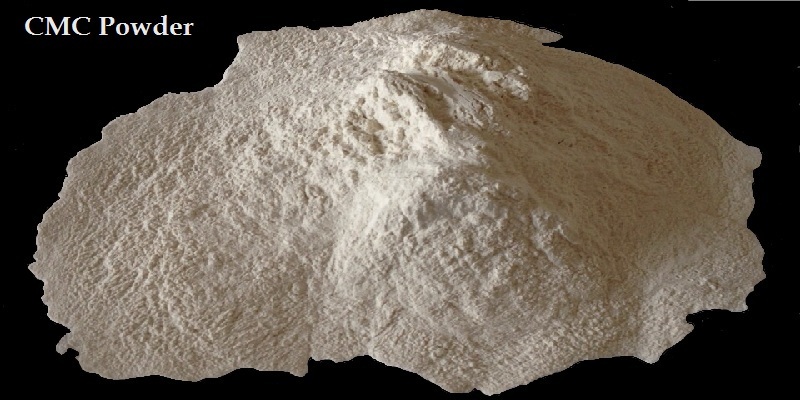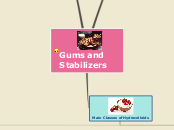
Gums and Stabilizers
Food hydrocolloids - a range of polyssaccharides and protein, known as 'water soluble gums', 'gums', 'stabilisers'

Functions
Primary
Thickening agents
Gelling/ Texturizing agents
Secondary
Emulsion stabilizers
Suspension of particulates
Crystallization contoller
Encapsulation
Film formation
Used less than 2% in food
Structure of hydrocolloid

High MW polymer, long chain sugar units with branches. Branches will determine ionic or non-ionic gums
Degree of Substitution (DS)
Higher DS - Faster to hydtrate
Lower DS - Slower to hydrate
Degree of Polymerization (DP)
Higher DP - High viscosity, slower to hydrate
Lower DP - Low viscosity, faster to hydrate

Factors affecting GUMS
Molecular weight
Monosaccharides composition
Side Chain
Type
Number
Distribution

Main Classes of Hydrocolloids
Derivatives from exudation/ sap/ trees

Gum Arabic/ gum acacia - sap exuded from various species of Acacia trees
Properties
Easily dissolve in hot/cold water
*most soluble of all hydrocolloids, 55% solid conc. can be used
Least viscous
Uses
Used in confectionery products
*to retard sugar crystallization, promote emulisification
Encapsulation agent
*to encapsulate visible flavour compounds
Foam in beer
*promote stabilization
Soft drink emulsion
*As emulsifier and stabilizers
Extract from part of plants

Pectin - from peel of citrus fruits/ apple pormace
Type of Pectin
High Methoxyl Pectin (HMP)
Formation of gel
Soluble solid content= About 55-85%
pH= About 2.8-3.8
Effect of pH in gelation
Rapid sey pectin will set at higher pH, higher temperature than slow set pectin
High DE, less soluble solid, higher pH which gels can be formed
Classified further into
ultrarapid/ rapid set (DE as high as 77)
Used in jams with whole fruits
*to ensure uniform distribution of fruits particles
slow set (DE as low as 58)
Suitable to very acid fruits
*to avoid premature gelation
DE- 58-75%
Setting times from 1-3 mins to more than 1 hr
Structure
Firm and short structure
Not heat reversible
Clear and transparent
Excellent flavour release
Low Methoxyl Pectin (LMP)
DE < 50%
Conventional LMP
*less reactive calcium ions than ALMP, used as thickening agent in yogurt fruit
Amidated LMP (ALMP)
*very reactive calcium ions , assist gelation in low sugar food preparation; e.g: low-sugar jams and jellies
Formation of Gel
Presence of Calcium ions
Low solid content
Wide pH range (1-7)
*soluble solid can be up to 85%

"egg-box" model
1. chain segment with 14/> residues having a ribbon-like symmetry forms parallel-oriented aggregates.
2. Calcium ions fit into cavities in the structure.
3. Chelate bonds with Oxygen from both galacturonan chains formed by calcium ions are formed.
Application
Used in jams with soluble solids <55%
*low calories jam, jellies preserves
Heat reversible
*utilised in bakery jams, jellies for glazing purpose
Gelation of Pectin
HMP: gels at high solids, low pH
HMP: DE increase, gelling ability increase
LMP: forms gel with calcium ions, loses ability as DE increases

Cellulose Derivatives - chemically modified cellulose through alkaline treatment that converts cellulose into an ether.
E.g: carboxymethylcellulose (CMC), hydroxypropylmethylcellulose (HPMC)
Properties
Very clear solution,
Stable over pH 4-10
Methylcellulose (MC) and HPMC gel when heated.
It also returns to origial liquid viscosities when cooled
Uses
Use in fried food to:
create barrier to oils absorption,
retard loss of moisture,
improve adhesion of batter
Extract from seed

Locust bean gums - from the seed of carob bean, seed of the leguminose Ceratonia siliqua (indigenous to Mediterranean countries)
Galactomannan gums
*made up of mannose and galactose, in ratio of 4:1
Properties
Insoluble in cold water
*must be heated to dissolve
Maximum viscosity develop when heated to 95 degree Celsius, then cooled
Does not form gel by itself
*combined with xanthan gums to gel
Non-ionic, stable over pH range 3.5- 11.0
Uses
Primary function:
thickening,
emulsion stabilizer,
inhibit syneresis

Canned foods, sauces, desserts, beverages, ice cream, processed meat

Guar gums - linear chain of mannose with single galactose units attached as side chains
Nongelling
*mainly used as viscosity builder, stabilizers and water binder
Properties
More highly substituted than LBG
*more soluble, hydrates fully in cold water giving high viscosity
Very stable from pH 4-10
Extract from seaweeds

Carrageenan - from seaweed of the rhodophyta family, composed of linear galactan polyssaccharides that have a sulfate content of 15-40%

Gelation of Carrageenan
Kappa and iota carrageenan has the ability to form thermoreversible gels upon cooling of hot aqueous solution containing various cation
Lambda carrageenan do not gel because it structure does not allow double helices formation
Structure of kappa & iota allow the two molecules to form double-helices-like structure, a chain molecules in 3-D network, a gel
Cations are important. Calcium ions and potassium ions form bridges between adjacent double helices through an electrostatic binding in two adjacent sulphate groups so, it stabilize and strengthening the network.
Type of Carrageenan

Iota, repeating unit is D-Galctose-4-Sulphate linked with 6-anhydrous-D-Galactose-2-Sulphate with 32% of sulphate content

Kappa, repeating unit is D-Galactose-4-Sulphate linked with 3,6-anhydrous-D-Galactose with 25% of sulphate content

Lambda, repeating of D-Galactose-2-Sulphate and D-Galactose-2,6-Disulphate with 35% of sulphate content

Alginate
from brown seaweed (Laminaria hyperborea), made up of blocks of D-mannuronic acid (M-block) and L-guluronic acid(G-block)
Properties
*Ratio of M:G and MW of polymer determine the solution and gelling properties
High G alginate forms strong, brittle gel with good heat stability
Can form gel in cold water in the presence of Ca ions,
*gel are thermoreversible
Application
Stabilizing effect in frozen products
e.g: ice cream to avoid crystallization, gives homogenous breakdown without whey separation
Thickener in beverages
e.g: dry mix fruit drinks, gives fast hydration and mouthfeel
Propylene glycol alginate (esterified form of alginate)
stabilize emulsion
e.g: mayonnaise/ low-fat mayonnaise
Extract from tubers

Konjac glucomannan
Microbial Gums

Xanthan Gums - polyssaccharides from the fermentation of CHO substrate with Xanthomonas campestris
Properties
~Completely soluble in cold water
~Viscosity - High viscosity at low concentration
~Stable to heat and pH - Remain unchanged across temp. range 0-100, pH 1-13
Uses
Thickening, suspending and stabilizing effects
Pseudoplastic - thin with shear and recover their initial viscosity when shearing stops - important for good flavour release, mouthfeel

Relative Ranking of Gums
Acid stability (pH<4.0)
Excellent
Pectin
Xanthan
Gellan
LBG
Tragacanth
Poor
Carrageenan
Cellulose derivatives
Fair
Guar
PGA
MCC
Gelatin
Alginate
Agar
Solution Clarity
Excellent
Cellulose
Carrageenan
Gellan
Gum Arabic
Gelatin
Agar
Good
Pectin
Refined LBG
Fair
Guar
Starch
LBG
Xanthan
Polyproplyene Alginate
Konjac
Microcystalline cellulose
Hydrocolloids Solubility in Various Temp.
Soluble in all temp. about range 25-90/>
Guar
Arabic
Xanthan
CMC
Pectin *85-90% soluble in temp. 25
Special cases
Gelatin
Soluble in temp. above 25 and swell at 25
Agar
Not soluble below temp. 70 and swell at 70
Soluble at temp. 90/>
Konjac
Swell below 90
Soluble at temp. 90?>
Gelling vs Thickening
Gelling
Pectin
Carrageenan
Gellan
Agar
Methyl Cellulose
Na alginate
Konjac
Gelatin
Thickening
Guar
LBG
CMC
PGA
Arabic
Tara
Tragacanth
Karaya
Xanthan
Natural vs Not Natural
Natural
HMP & LMP
Carrageenan
Tragacanth, Karaya
Agar, Gelatin
Na alginate, Guar, Tara
Xanthan, Gellan
Konjac, Arabic
LBG
Not Natural
MC
HPC
CMC
PGA
LMA Pectin
Suspension Ability
Gums with Useful Protein Reactivity
Pectin (pH< 4.6)
Carrageenan (pH> 4.6)
Suspension Requires a Gelling Agent
Chocolate milk - carrageenan
Salad dressing - Xanthan, Pectin
Processed Fruits - Pectin
